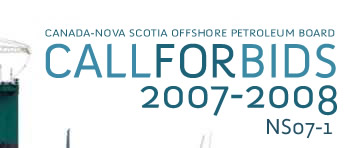
CANADA-NOVA SCOTIA OFFSHORE PETROLEUM BOARD


Royalty Regime
The following information has been provided by the Nova Scotia Department of Energy.
Overview
Nova Scotia has an Offshore Petroleum Royalty Regime that is based upon revenues and profits. The regime is designed to recognize the inherent risks involved in offshore oil and gas exploration and production. The generic royalty regime is explicitly designed to encourage risk-taking by offering lower royalties for the first project in a new area – a so called “high risk project”.
Authority
The authority for the Government to put in place regulations that set royalty levels for oil and gas projects in the offshore Nova Scotia area comes from the Offshore Petroleum Royalty Act. The Act also provides for royalty agreements to be put in place between offshore production license holders and the government of Nova Scotia.
In July of 1999, generic royalty regulations were put in place that would apply to future offshore oil and gas projects. The generic royalty regime stipulates that royalty will be a function of both the value of petroleum leaving a project boundary as well as profits associated with the operation of a project.
Royalty is initially set as an increasing percentage of gross revenues before it switches to increasing percentages of net revenues. Royalty rates increase with project profitability. Once net revenue royalty levels are reached, royalty cannot be less that a specified level of gross revenues.
Royalty Terminology
| Gross Revenues (GR): | The value of petroleum leaving the boundary of an offshore project. |
| LTBR: | Long Term Government of Canada Bond Rate (10 year). |
| Net Revenue (NR): | The gross revenue of a project less the costs associated with getting the petroleum to the project boundary. |
| Return Allowance (RA): | A percentage of unrecovered project costs. Once simple payout is achieved, the return allowance ceases to be calculated. |
| Simple Payout: | The point at which project revenues first reach or exceed the sum of allowed exploration costs, capital costs, operating costs and royalties paid. Corporate income tax is not an allowed cost for royalty purposes. |
Generic Royalty Regime
BASE REGIME
| GROSS REVENUE ROYALTY | |
| Tier 1 | 2% GR, until simple payout + RA based on 5% + LTBR |
| Tier 2 | 5% GR until simple payout + RA based on 20% + LTBR |
| NET REVENUE ROYALTY | |
| Tier 3 | 20% NR until simple payout + RA based on 45% + LTBR* |
| Tier 4 | 35% NR * |
SMALL OIL
| GROSS REVENUE ROYALTY | |
| Tier 1 | 2% GR until later of 2 years or simple payout + RA based on 5% + LTBR |
| Tier 2 | 5% GR until later of 3 years or simple payout + RA based on 20% + LTBR |
| NET REVENUE ROYALTY | |
| Tier 3 | Same as Tier 3 of BASE REGIME * |
| Tier 4 | Same as Tier 4 of BASE REGIME * |
HIGH RISK
| GROSS REVENUE ROYALTY | |
| Tier 1 | Same as Tier 1 of BASE REGIME |
| Tier 2 | Same as Tier 2 of BASE REGIME |
| NET REVENUE ROYALTY | |
| Tier 3 | 20% NR * |
* Minimum of 5% GR payable
For projects that fall under the Base Regime, only successful finding costs are allowed costs for royalty purposes. For projects that fall under the Small Oil or High Risk regimes, in addition to successful exploration costs, unsuccessful exploration costs associated with the project may be allowed costs for royalty purposes.
The royalty regime is administered by the Province of Nova Scotia. For more information on royalties offshore Nova Scotia including areas designated as High Risk for royalty purposes, please contact:
Chris Spencer C.A.
spencecc@gov.ns.ca
Manager, Royalty Policy, Audit and Assessment
Resource Assessment & Royalties Division
Nova Scotia Department of Energy
P.O. Box 2664 400
Bank of Montreal Bldg
5151 George Street
Halifax, Nova Scotia B3J 3P7